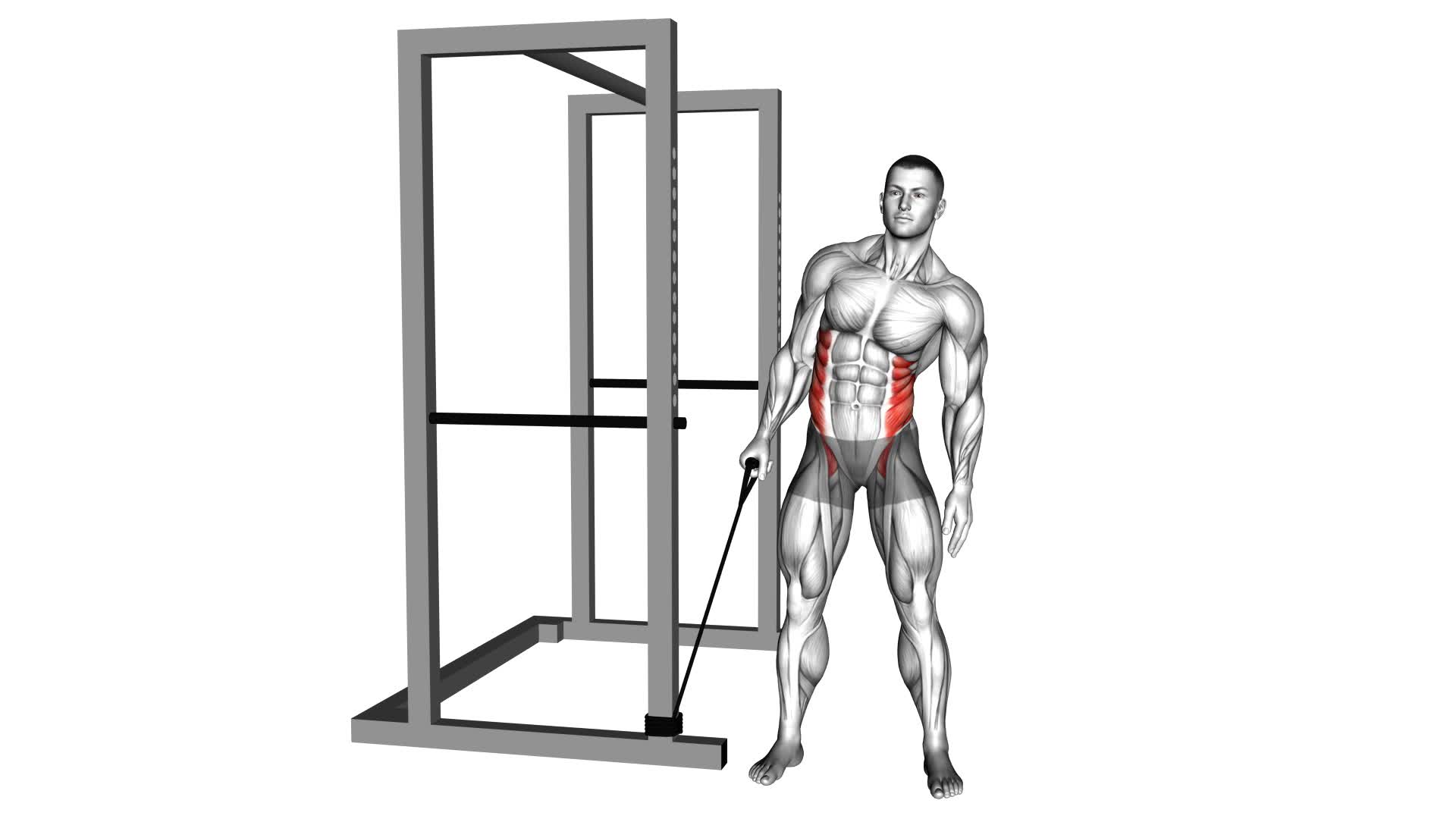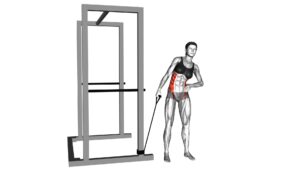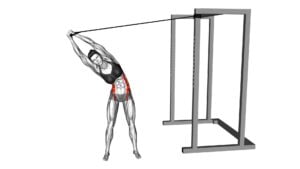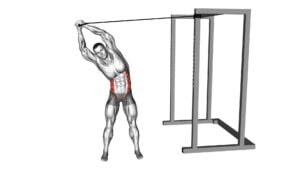Band Side Bend (Male) – Video Exercise Guide & Tips

Looking to strengthen your core and build those oblique muscles? The Band Side Bend is the perfect exercise for you.
Watch This Exercise Video
In this video exercise guide, we'll show you the proper technique and form, as well as variations and progressions to keep challenging yourself.
Avoid common mistakes and get the most out of your workout routine by incorporating the Band Side Bend.
Get ready to feel the burn and see results with this effective exercise.
Key Takeaways
- Band side bend improves core stability and targets deep core muscles.
- It enhances control and balance in other exercises and daily activities.
- Band side bend helps to correct imbalances between the left and right sides of the body.
- It can be a useful exercise for athletes and individuals involved in sports that require rotational movements.
Benefits of the Band Side Bend
To experience the benefits of the Band Side Bend, you need to engage your core muscles and maintain proper form throughout the exercise. This exercise is highly effective in improving core stability and increasing oblique strength.
When you perform the Band Side Bend, the resistance from the band forces your core muscles to work harder to stabilize your body. This helps to strengthen the deep muscles of your core, including the transverse abdominis and the internal and external obliques. As a result, your core stability improves, allowing you to have better control and balance during other exercises and daily activities.
Additionally, the Band Side Bend specifically targets and strengthens your oblique muscles. These muscles are responsible for bending and twisting movements of the torso. By regularly incorporating this exercise into your routine, you can expect to see increased strength and definition in your obliques.
It is important to note that to fully reap the benefits of the Band Side Bend, you must maintain proper form throughout the exercise. This means keeping your back straight, your abs engaged, and avoiding excessive leaning or twisting. By doing so, you'll maximize the effectiveness of the exercise and prevent any unnecessary strain on your muscles or joints.
Proper Form and Technique for the Exercise
To properly execute the Band Side Bend exercise, you should focus on maintaining correct form and technique. Start by standing with your feet shoulder-width apart and holding the band with both hands. Keep your arms straight and raise them above your head, creating tension in the band. Engage your core muscles and maintain a neutral spine throughout the exercise.
To perform the movement, slowly bend your torso to the side, keeping your arms and upper body straight. Focus on contracting the oblique muscles on the opposite side of the bend. Hold the position for a second and then return to the starting position in a controlled manner. Repeat the exercise on the other side.
Maintaining proper form is crucial to ensure the effectiveness of the exercise and prevent injury. Avoid leaning forward or backward, and keep your hips stable throughout the movement. Remember to breathe consistently and maintain a steady tempo.
If you're looking to improve oblique strength but don't have access to a resistance band, there are alternatives to the Band Side Bend. Side plank variations, Russian twists, and bicycle crunches are all great exercises that target the oblique muscles.
Now that you understand the proper form and technique for the Band Side Bend, let's explore variations and progressions of this exercise to further challenge your oblique muscles.
Variations and Progressions of the Band Side Bend
Now that you understand the proper form and technique for the Band Side Bend, let's explore variations and progressions of this exercise to further challenge your oblique muscles.
As you continue to strengthen your core, incorporating different resistance levels or adding dynamic movements can help enhance the effectiveness of the Band Side Bend.
One way to progress the Band Side Bend is by increasing the resistance of the band. This can be done by using a band with a higher tension or by doubling up on bands to create a greater challenge for your obliques. By increasing the resistance, you're forcing your muscles to work harder and adapt to a higher level of intensity.
Another progression of the Band Side Bend is to add dynamic movements. Instead of simply bending to the side, you can incorporate rotational movements or perform the exercise in a kneeling or standing position. These variations engage additional muscles and require more stability and control.
Modifications can also be made to the Band Side Bend to accommodate different fitness levels or to target specific areas. For beginners or those with limited mobility, the exercise can be performed with a lighter resistance band or without a band at all. Additionally, you can focus on bending to the front or back to target different parts of the oblique muscles.
Common Mistakes to Avoid
As you progress with the Band Side Bend and challenge your oblique muscles, it's important to be aware of common mistakes to avoid. Proper technique is crucial to maximize the effectiveness of this exercise and prevent injuries.
One common mistake is using too much weight or resistance. While it's important to challenge yourself, using too heavy of a band or weight can compromise your form and put unnecessary stress on your spine. Start with a lighter resistance and gradually increase as you become more comfortable and confident with the movement.
Another mistake to avoid is leaning too far forward or backward during the exercise. This can lead to improper engagement of the oblique muscles and put strain on your lower back. To maintain proper form, imagine a straight line from your head to your hips throughout the movement. Keep your core engaged and focus on bending sideways, not forward or backward.
Lastly, rushing through the exercise is another common mistake. Take your time and perform the Band Side Bend with control. Slow and controlled movements allow for better muscle activation and reduce the risk of injury.
By avoiding these common mistakes and practicing proper technique, you can ensure that you're getting the most out of the Band Side Bend exercise.
Now, let's move on to the next section where we'll discuss some tips for incorporating the band side bend into your workout routine.
Tips for Incorporating the Band Side Bend Into Your Workout Routine
To maximize the effectiveness of the Band Side Bend exercise and incorporate it into your workout routine, it's important to follow these tips:
- Proper Breathing Technique: When performing the Band Side Bend, it's crucial to maintain a steady and controlled breathing pattern. Inhale deeply through your nose as you prepare to bend to the side, and exhale slowly through your mouth as you return to the starting position. This will help stabilize your core muscles and enhance the overall effectiveness of the exercise.
- Modify for Different Fitness Levels: The Band Side Bend can be modified to suit different fitness levels. If you're a beginner or have limited flexibility, start by using a lighter resistance band or no band at all. Focus on mastering the proper form and gradually increase the resistance as you become more comfortable. For advanced individuals, you can use a heavier resistance band or even incorporate additional sets and repetitions to challenge yourself further.
- Listen to Your Body: It's important to listen to your body and pay attention to any discomfort or pain during the Band Side Bend. If you experience any sharp or intense pain, stop immediately and consult with a healthcare professional. Additionally, make sure to warm up properly before performing this exercise to prevent any potential injuries.
Frequently Asked Questions
Can the Band Side Bend Exercise Help Me Achieve a Six-Pack or Visible Abs?
Yes, the band side bend exercise can definitely help you achieve a six-pack or visible abs. By targeting the oblique muscles, this exercise helps to strengthen and tone your core, leading to more defined abs.
To maximize your results, you can combine the band side bend with other abdominal exercises like crunches or planks.
Additionally, there are modifications and variations of the band side bend that can specifically target different areas of your abs, providing a well-rounded workout for your entire core.
How Many Repetitions and Sets Should I Aim for When Performing the Band Side Bend Exercise?
When performing the band side bend exercise, it's important to know how many repetitions and sets to aim for.
This exercise targets your oblique muscles, helping to strengthen and tone them.
To get the most out of it, aim for 3 sets of 12 to 15 repetitions. This will challenge your muscles and promote growth.
Is the Band Side Bend Exercise Suitable for Individuals With Lower Back Pain or Back Injuries?
If you have lower back pain or back injuries, it's important to be cautious when performing the band side bend exercise.
There are modifications you can make to make it safer for you, such as using a lighter resistance band or reducing the range of motion.
However, it may be best to avoid this exercise altogether and opt for alternatives that target the same muscles without putting strain on your back, like side planks or standing side bends.
Can I Use a Resistance Band With Handles Instead of a Loop Band for the Side Bend Exercise?
Yes, you can definitely use a resistance band with handles instead of a loop band for the side bend exercise.
It's important to maintain proper form throughout the exercise to avoid any strain or injury.
To do this, make sure to stand with your feet shoulder-width apart, hold the resistance band firmly with both hands, and keep your core engaged.
Slowly bend to the side, focusing on the contraction of your oblique muscles.
Are There Any Specific Breathing Techniques I Should Follow During the Band Side Bend Exercise?
When doing the band side bend exercise, it's important to focus on your breathing. Take a deep breath in as you lift the band overhead, and exhale as you bend to the side. This helps engage your core and maintain stability.
If you're a beginner, start with a lighter resistance band or modify the exercise by holding onto a stable object for support. Remember to listen to your body and adjust as needed.
Conclusion
Incorporating the band side bend into your workout routine can offer numerous benefits. This exercise specifically targets your obliques, which are the muscles on the sides of your core. Strengthening these muscles can improve your overall core stability and help with everyday movements and activities.
To perform the band side bend, start by standing with your feet shoulder-width apart and holding a resistance band in both hands. Place the band behind your head, with your elbows bent and pointing out to the sides.
Next, engage your core muscles and slowly bend to one side, keeping your back straight and your hips stable. Only bend as far as you can while maintaining proper form and control.
Avoid common mistakes, such as using too heavy of a resistance band or bending too far to the side, which can strain your muscles and increase the risk of injury.
If you're new to this exercise, start with a lighter resistance band and gradually increase the tension as you become stronger and more comfortable with the movement.
Remember, it's always a good idea to consult with a fitness professional before adding any new exercise to your routine. They can provide guidance on proper form and technique, as well as help you tailor your workouts to your specific fitness goals and abilities.
So grab a resistance band and start incorporating the band side bend into your workouts for a stronger, more stable core.

Author
Years ago, the spark of my life’s passion ignited in my mind the moment I stepped into the local gym for the first time. The inaugural bead of perspiration, the initial endeavor, the very first surge of endorphins, and a sense of pride that washed over me post-workout marked the beginning of my deep-seated interest in strength sports, fitness, and sports nutrition. This very curiosity blossomed rapidly into a profound fascination, propelling me to earn a Master’s degree in Physical Education from the Academy of Physical Education in Krakow, followed by a Sports Manager diploma from the Jagiellonian University. My journey of growth led me to gain more specialized qualifications, such as being a certified personal trainer with a focus on sports dietetics, a lifeguard, and an instructor for wellness and corrective gymnastics. Theoretical knowledge paired seamlessly with practical experience, reinforcing my belief that the transformation of individuals under my guidance was also a reflection of my personal growth. This belief holds true even today. Each day, I strive to push the boundaries and explore new realms. These realms gently elevate me to greater heights. The unique combination of passion for my field and the continuous quest for growth fuels my drive to break new ground.



